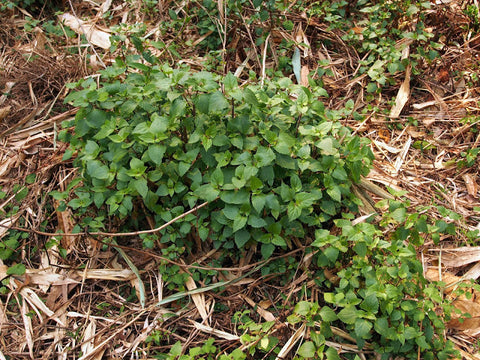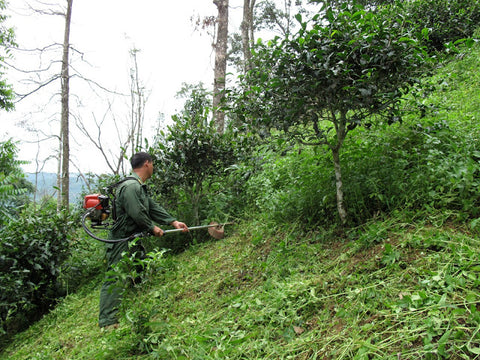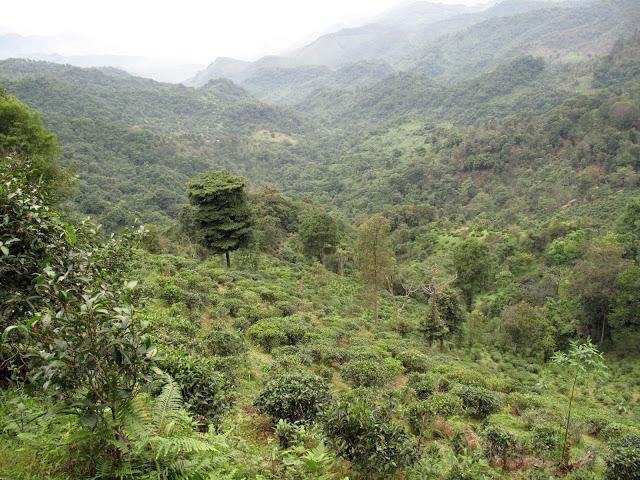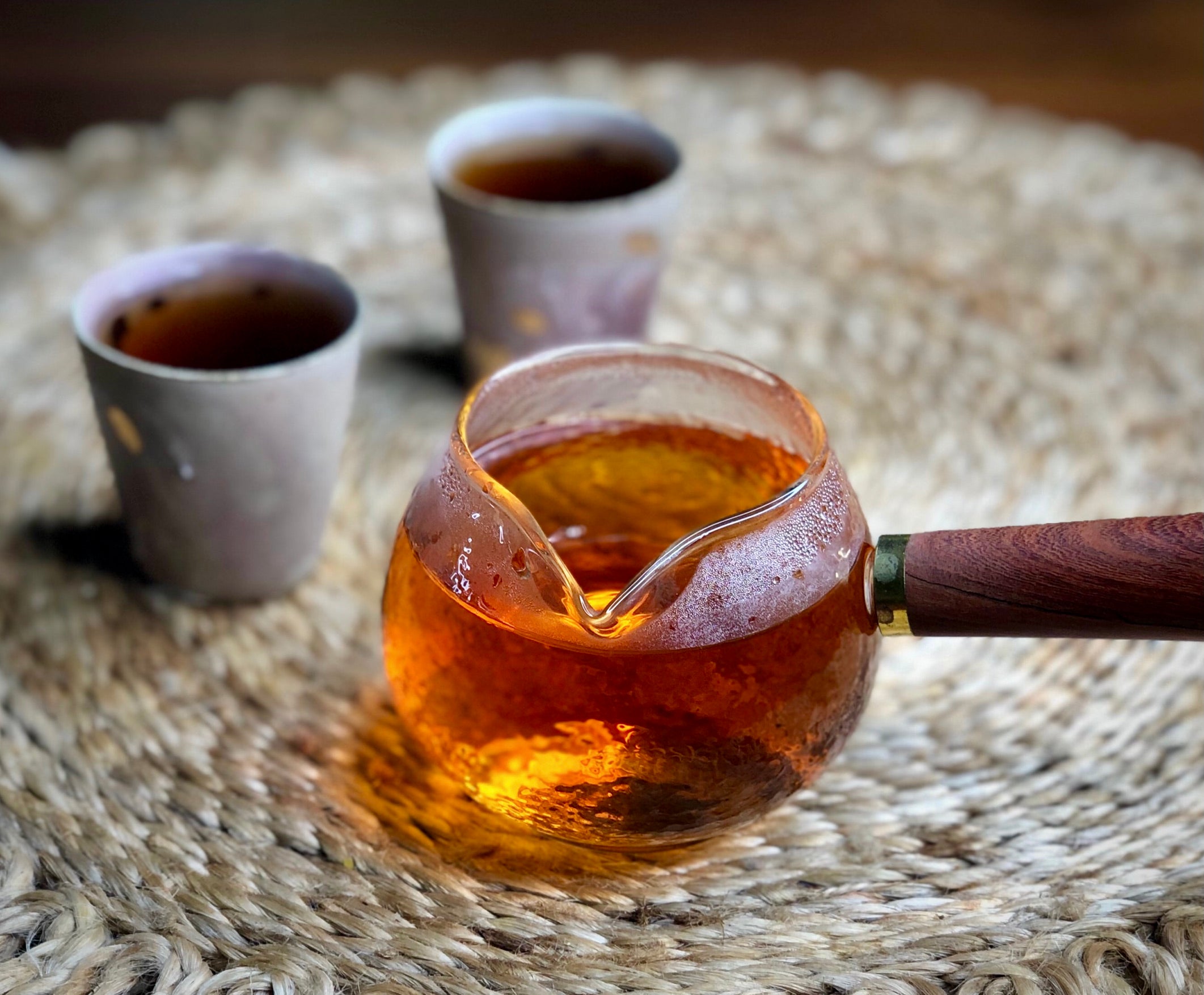
Biodiverse tea garden in Luo Shui Dong, Yiwu
One of the reasons we love ancient tree puer, is the biodiversity of the tea gardens. Often growing in, or around natural forest cover, the trees grow at wide intervals, with an overstory of shade trees and an understory of leaf litter, grasses & wildflowers.

Picking tea in the forest, Pasha
However, not all gushu orchards are free from the chemical sprays & fertilizers used in more intensive terraced tea farms. For us tea drinkers, it may seem like madness to spray a tea farm, as the leaves cannot be washed, before being consumed. But from a farmer’s perspective, spraying pesticides is common across all crops. They believe the government has ensured the chemicals are safe for human consumption.
One of the challenges of tea farming, is making sure other plants don’t crowd out your tea trees, and compete for nutrients & water. Left unmanaged, the weeds can grow taller than a man, making the tea trees difficult to reach & harvest. On the steep slopes, tall weeds make it hard to find a foothold, and increase the chance of being bitten or stung by insects, leeches, poisonous centipedes & snakes. Even in “managed” tea gardens, I’ve been stung by stinging nettles, and emerged covered from the knee down in hundreds of prickly seeds. For this reason farmers tend to cover themselves from head to foot when picking tea. Military fatigues are a fashion across Yiwu for their low cost & practicality. You don’t see tea pickers in shorts & a t-shirt!

Can you see the contrast between sprayed & unsprayed areas?
Farmers need to manage the undergrowth, before tea picking begins. The grass needs to be mown twice a season, or ploughed back into the soil once a season. Ploughing is usually done by hand in June and November. Unfortunately, a small minority of lazy farmers still prefer to spray weed killer. Leafless, blackened stalks are a clear sign of recent use of herbicide. Another warning sign is tea gardens which only have 1 or 2 species in the undergrowth, these are the regrowth of resistant species. There's also the grass-pull method, using two fingers. If the grass comes out easily and has a shallow root system, it may indicate recent spraying has stunted the growth of the grass.

Black stalks and resistant species regrowth indicates this plot has been sprayed with weed killer
A lot of Yunnan's tea gardens are plagued by "Liberation grass" 解放草 a group of invasive species which arrived after the communist party won the civil war and unified the country. As trade resumed, roads were built, and thousands of young students were sent from cities like Shanghai to help develop the Yunnan economy. With them came these new fast growing, noxious weeds. Crofton weed is particularly pernicious, as it likes steep slopes, is shade tolerant, and grows quickly up to 2m in height, releasing thousands of tiny wind borne seeds spread rapidly across tea gardens that have been sprayed or ploughed. It has infested the roadsides and tea gardens of Yunnan, sometimes it's the only ground cover there is.

Crofton weed, or "Liberation grass" 解放草 as it's colloquially known in Yunnan
I’m of two minds when it comes to ploughing, which due to the steep slopes, is usually done with a hoe. Tea farmers do this because they don't like weeds competing for scarce water during the dry picking season. Turning over the soil kills the weeds & aerates the soil. But ploughing exposes the topsoil to the eroding effects of wind & rain, and also damages the roots of the tea trees. The turned soil is baked by the sun, and hardens to clods of fine clay dust. On the steep slopes, rain can easily wash away nutrients, and at the top of the mountain, topsoil cannot be readily replenished.

Ploughed Bulang tea garden, showing signs of erosion and exposed roots
Ploughing has one advantage over mowing - you only need to do it once per season. It is actually more arduous for a farmer to mow the grass twice per season. Cutting grass on a 45 to 70 degree slope, is extremely uncomfortable, sweaty work, but preserves the biodiversity of the tea garden, and the root systems that hold the soil together.

Our Luo Shui Dong supplier cutting the grass in his tea garden
Occasionally you’ll see people spraying the weeds by the side of the road, to reduce drain blockage and improve visibility. This means tea gardens below the road may be affected by run off. So it’s best to source from tea farms higher up the mountain, away from roads that have been sprayed and any patches of intensive farming, especially rubber tree plantations. ZhangJiaWan and YiShanMo are valued for this reason. Taking it a step further, groves of tea trees hidden away in the forest, several kilometers from the nearest human habitation, are the least likely to have been sprayed. This is partly why Wangong and Gua Feng Zhai have risen to become the most highly priced teas in Yiwu.

Spraying kit for herbicide & insecticide, for sale in Bulang town
Spotting a spraying kit in the farmer’s house doesn't necessarily mean they spray their tea trees. They may use it to spray their other crops (eg. rice, corn, rubber, cassava, sugarcane), or to spray stagnant pools of water to prevent malaria. The critical test is the taste test. Chemically assisted tea is scratchy in the throat, has a lasting astringency, and just doesn’t taste natural. Unfortunately, use of chemical sprays & fertilizers in tea production is still prevalent in intensive monoculture, terrace tea plantations, including TieGuanYin and Longjing, which I’ve actually seen being sprayed. But overall, pesticide use is very rare in ancient tree puer plantations, firstly because the trees are big & hardy enough to have survived for hundreds of years without chemical protection, and secondly because buyers like ourselves won’t buy tea that has been treated with “nongyao” (agricultural medicine).
Greed is often cited as the reason farmers use pesticides, but most farmers with large gushu trees are well aware that although chemicals may boost short term yields, they actually lower the demand for their product and decrease the lifetime value of their trees. In places like Mahei where pesticide use is widespread, the maocha price per kg has actually fallen behind other Yiwu villages. Mahei used to be famous as one of the best tasting Yiwu teas, but their use of nongyao (and their unrepentant blending of xiaoshu with gushu) has ruined their reputation.
In more famous tea producing villages like Lao Ban Zhang, pesticides and fertilizers have been banned outright, in an effort to protect their reputation for quality. Below is a similar policy from Mangfei, in Yongde, Lincang, which phased out chemical fertilizers in 2012.

Left: Mangfei government policy prohibiting chemicals in tea farming, on the right: a bag of potassium oxide fertilizer
Nitrogen & potassium fertilizers are expensive, and were not widely used by tea farmers in Yunnan until puer prices rose dramatically over the past decade. The fertilizer boosts yield but adds an unbalanced chemical taste to the tea. In my experience, it tends to be used more on large scale industrial farms. Whilst I've read stories on the internet of farmers sprinkling their old trees to get more out of them, I haven't been able to corroborate this story on the ground. Regular pruning & plucking is the predominant form of getting an old tree to flush more, and farmers for the most part, are not as greedy as internet speculation would have you think.
Ultimately, the buyer must do his/her best to understand the tea trees, the farming practices, and the tea farmers. To get good tea, you have to first find good people. It's not practical (or respectful) to live with the farmer throughout the year, observing their every step, like a policeman. Our tea business is built on trust, on being observant & knowledgeable, and always, on the final judgement of our palate.

A biodiverse tea forest in Baotang. Only the soil around the base of each trees has been turned.
Editors note: Since publishing this article, I've come across a number of related posts that I recommend. Hobbe's of The Half-Dipper wrote Pesticide: It's what's for dinner and Mark from Zhi Zheng wrote about Round Up in tea farming on his excellent blog "The Horses Mouth" (a must follow for any lover of puer).
And it's not just tea producers who love glyphosates. Aussie wine maker and wheat growers are now faced with a resurgence of resistant wild radish. See Philip White's blog Drinkster where he recently posted Feeling Herbicidal?

